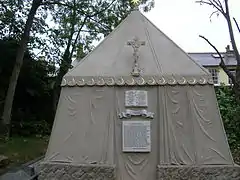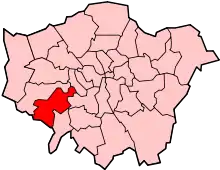Mortlake
Mortlake is a suburban[2] district of the London Borough of Richmond upon Thames on the south bank of the River Thames between Kew and Barnes. Historically it was part of Surrey and until 1965 was in the Municipal Borough of Barnes. For many centuries it had village status and extended far to the south, to include East Sheen and part of what is now Richmond Park. Its Stuart and Georgian history was economically one of malting, brewing, farming, watermen and the Mortlake Tapestry Works (1617-1704), Britain's most important producer. A London landmark, the former Mortlake Brewery or Stag Brewery, is on the edge of Mortlake.
| Mortlake | |
|---|---|
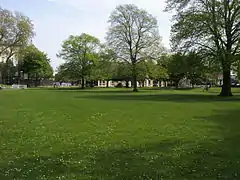 Mortlake Green | |
 Mortlake Location within Greater London | |
| Area | 4.50 km2 (1.74 sq mi) |
| Population | 10,919 (Mortlake and Barnes Common ward 2011)[1] |
| • Density | 2,426/km2 (6,280/sq mi) |
| OS grid reference | TQ205755 |
| London borough | |
| Ceremonial county | Greater London |
| Region | |
| Country | England |
| Sovereign state | United Kingdom |
| Post town | LONDON |
| Postcode district | SW14 |
| Dialling code | 020 |
| Police | Metropolitan |
| Fire | London |
| Ambulance | London |
| UK Parliament | |
| London Assembly | |
The Waterloo to Reading railway line runs through Mortlake, which has a pedestrianised riverside, two riverside pubs and a village green. The Boat Race finishes at Mortlake every March/April.
Governance
The Mortlake and Barnes Common ward of the London Borough of Richmond upon Thames has proved highly marginal. In the 2010 local elections local Liberal Democrats lost all three seats to local Conservatives, the latter forming an administration on Richmond Council. This remained the case until the 2018 local elections when the Liberal Democrats regained one of the three seats by a single vote.[3] The Liberal Democrats also regained control of the Council. Richmond Park, the constituency which includes Mortlake, had changed from Liberal Democrat to Conservative in the 2010 general election, was recaptured by the Liberal Democrats in the 2016 by-election, and finally reverted to Conservative MP Zac Goldsmith in the 2017 general election by a margin of only 45 votes.[4] During the 2016 United Kingdom European Union membership referendum, Richmond Park voted 69.3% for Remain, with a turnout of 82%.[5] Zac Goldsmith's pro-Brexit position, including voting to leave the European Union without a deal,[6] was hypothesised [7] to have damaged his support in the constituency. The 2019 election was won by Sarah Olney for the Liberal Democrats with a majority of 7766.[8]
The London Assembly constituency South West, which includes Mortlake, is represented by former local councillor Tony Arbour (Conservative).
History

The place-name 'Mortlake' is first attested in the Domesday Book of 1086, where it appears as Mortelaga and Mortelage, a name with two possible derivations. If the second element is the Old English lacu meaning a stream, then the first element is very likely the fish-name mort meaning a young salmon, hence 'salmon stream'. If the second element is the dialect lag meaning a long, narrow marshy meadow, then the name means 'Morta's meadow'.[9]
Mortlake lay in the hundred of Brixton, which faded into obscurity.[10]
According to the Domesday Book, the manor and parish of Mortlage [11] was held by Archbishop Lanfranc of Canterbury when its assets were: 25 hides; 1 church, 2 mills worth £5, 1 fishery, 33 ploughs, 20 acres (8 hectares) of meadow, wood worth 55 hogs. It rendered a large £38 plus 4s 4d from 17 houses in London, 2s 3d from houses in Southwark and £1 from tolls at Putney per year to its feudal system overlords.[11] The manor belonged to the Archbishops of Canterbury until the time of Henry VIII, when it passed by exchange to the Crown. From the early part of the 17th century until after the English Civil War, Mortlake was celebrated for the manufacture of tapestry, founded during the reign of James I at the Mortlake Tapestry Works.
Mortlake was reduced by 732 acres (296 hectares) when Richmond Park was created by Charles I in 1637. Other parishes also lost smaller amounts of land to the new deer park.[12]
Colston House's forebear was built by Thomas Cromwell, Earl of Essex then acquired by Edward Colston, major benefactor and investor to the port city of Bristol. This was pulled down in 1860. John Barber, Lord Mayor in 1733, a suspected Jacobite opposed to the 'Georgian' House of Hanover but Member of Parliament for the City on the strength of his opposition to Walpole's protectionist excise scheme, was buried in Mortlake in 1741. He had given land to extend the churchyard. Sir Henry Taylor, KCMG, the dramatic poet, lived in Mortlake in the 19th century.[13]
Sir John Barnard, Lord Mayor of London in the year 1737 and also an MP, used public addresses and private campaigns to outstanding effect in supporting the government against the Jacobite movement in 1745.[13]
Since 1845, the Oxford and Cambridge Boat Race has had its finish point at Mortlake, marked by the University Boat Race stone just downstream of Chiswick Bridge. Several other important rowing races over the Championship Course also either start or finish at the stone. The first National School in Mortlake was built providing compulsory education at primary level in 1869, followed by an infants school in 1890 and county level, into secondary level school in 1906.
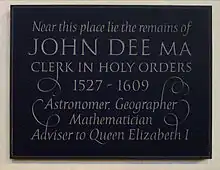
People
Living people
Katherine Jenkins, classical singer, lives in Mortlake.[14]
Historical figures
Mortlake's most famous former resident is John Dee (1527–1608/09), mathematician, astronomer, astrologer, alchemist and adviser to Queen Elizabeth I. He lived at Mortlake from 1565 to 1595 except for the six years between 1583 and 1589 when he was travelling in Europe. His house no longer exists but it became the Mortlake Tapestry Works and at the end of the 18th century was a girls' school.[15]
Sir Christopher Packe (1593?–1682), Lord Mayor of London, lived in Mortlake in about 1655–60.[16]
John Partridge (astrologer) (1644–c.1714) was born at East Sheen and apprenticed to a local shoemaker. He died in Mortlake and is buried there.[16]
The cemetery of St Mary Magdalen’s Roman Catholic Church Mortlake contains the tomb of the Victorian explorer and orientalist Sir Richard Burton.[17] Former British Prime Minister Henry Addington who, as Lord Sidmouth, was Ranger of Richmond Park, and after whom the park's Sidmouth Plantation is named, is buried at St Mary the Virgin Mortlake.[17][18]
Ada Lovelace (1815–1852), an English mathematician and writer, lived in Mortlake when she was 15 years old.[19]
Economy
Mortlake is mostly a residential commuter town with a strong history of self-employed trades as it has traditionally centred its commerce on its foreshortened boundary, the Upper Richmond Road, arguably half part of East Sheen. Some businesses on the north side of the Upper Richmond Road make reference to the old ecclesiastical and ward boundaries supported by their still Mortlake side streets.[20] East Sheen was once a manor in the parish of Mortlake and since early times an economic forum, and now a dining and convenience hub of the two districts. The Victoria County History's volume on Surrey, written from 1910 to 1912, does not list East Sheen as a parish, describes its detailed history under Mortlake and states the parish was "now connected with Barnes on one side and with New Richmond on the other".[13][21] With the advent of motor transport, the buildings on Mortlake's winding high street, also known as the Lower Mortlake Road, have been mostly residential or used by the brewery.
Stag Brewery or Mortlake Brewery
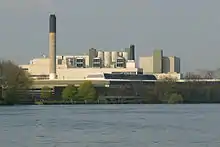
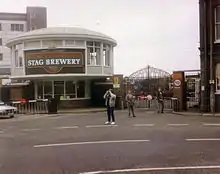

In the 1840s Charles James Philips and James Wigan acquired Mortlake Brewery, which had existed since the 15th century.[22]
In 1889 the brewery was acquired by James Watney & Co., which in 1898 became Watney Combe & Reid after acquiring Messrs. Combe Delafield and Co. and Messrs. Reid and Co. When Watney's Stag Brewery in Victoria, London, was demolished in 1959, the name was 30 years later, applied to Mortlake Brewery. Being the last phase of The Boat Race which refers to all the traditional local names, it is still widely referred to as the Mortlake Brewery.[22]
The brewery became part of Scottish Courage, briefly part of Heineken and was then divested to Anheuser-Busch Europe Ltd as it produced the company's Budweiser pale lager. In January 2009, Anheuser-Busch InBev said that the company was proposing to close the Stag Brewery in 2010 as a result of a merger between InBev and Anheuser-Busch.[23] In November 2015, it was announced that the site had been sold for £158m to Reselton – part of Singapore’s City Developments, which also bought the former Teddington Studios. The brewery closed in December 2015[24] and there are plans to build 850 apartments on the 22-acre (9-hectare) location.[25]
Mortlake Railway Station – Queen Victoria's Waiting Room
The building next to Mortlake Railway Station, now occupied by a classic car showroom, contains Queen Victoria's old waiting room which was built for her and Prince Albert to use due to their frequent visits to White Lodge in Richmond Park where their family and latterly their son the Prince of Wales (later Edward VII) were living.
Amenities
Mortlake affords an undistracted view of the river as its riverside promenade is set by its buildings including the former brewery, unlike the embankment style roads along other London banks such as in Barnes until Barnes Bridge.
The two large pubs at either end of the riverside promenade are not listed buildings:
- The White Hart
- The Ship
Places of worship include:
Transport
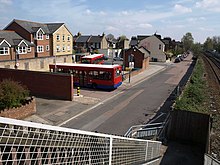
Adjoining districts
- Barnes
- Chiswick (Grove Park, after which is Old Chiswick or Strand-on-the-Green, depending on direction)
- East Sheen
- Kew
Nearest railway stations
These are minor stops on the Waterloo to Reading Line which has four branch lines: to Windsor Riverside station, to Weybridge and back to the London terminus via Kingston upon Thames or Brentford.
This railway is a narrow bisector of the settlement, being generally on the flat with its streets, which tend to run perpendicular to it. It runs in the middle of Worple Way, separating it into north and south sides.
Demography and housing
To ensure that all the local authority wards have electorates of approximately the same size, the ward covering Mortlake also includes parts of Barnes.
| Ward | Detached | Semi-detached | Terraced | Flats and apartments | Caravans/temporary/mobile homes/houseboats | Shared between households[1] |
|---|---|---|---|---|---|---|
| Mortlake and Barnes Common | 167 | 547 | 1,765 | 2,453 | 1 | 8 |
| Ward | Population | Households | % Owned outright | % Owned with a loan | hectares[1] |
|---|---|---|---|---|---|
| Mortlake and Barnes Common | 10,919 | 4,771 | 27 | 32 | 185 |
References
- Key Statistics; Quick Statistics: Population Density Office for National Statistics
- A City of Villages: Promoting a sustainable future for London's suburbs (PDF). SDS Technical Report 11. Greater London Authority. August 2002. ISBN 1-85261-393-9. Retrieved 16 January 2014.
- "Election results for Mortlake and Barnes Common, 3 May 2018". 3 May 2018. Retrieved 10 May 2018.
- Glaze, Ben (9 June 2017). "All the latest 2017 general election results and fallout as Tories lose seats". Daily Mirror. Archived from the original on 8 June 2017.
- "EU Referendum local results". BBC. Retrieved 24 January 2020.
- ""Lord Goldsmith of Richmond Park: UK Membership of the European Union"". Retrieved 24 January 2020.
- Merrick, Jane. "True Blue Tories in swing seat Richmond turned off by the Brexit purge". i. Retrieved 24 January 2020.
- "Election Results for Richmond Park (12 December 2019)". Retrieved 24 January 2020.
- Ekwall, Eilert, The Concise Oxford Dictionary of English Place-names, p.331.
- Malden, H E (editor) (1912). "The hundred of Brixton: Introduction and map". A History of the County of Surrey: Volume 4. Institute of Historical Research. Retrieved 21 December 2013.CS1 maint: extra text: authors list (link)
- Lysons, Daniel (1792). "Mortlake". The Environs of London: volume 1: County of Surrey. British History Online. Retrieved 27 July 2013.
- Brown, Maisie (1997). Barnes and Mortlake Past, with East Sheen. Historical Publications. p. 18. ISBN 0-948667-46-X.
- Malden, H E (editor) (1912). "Parishes: Mortlake". A History of the County of Surrey: Volume 4. Institute of Historical Research. Retrieved 21 December 2013.CS1 maint: extra text: authors list (link)
- Ambrose, Tom (31 December 2013). "Katherine Jenkins heads list of Richmond residents with honours". Richmond and Twickenham Times. Retrieved 21 January 2014.
- "Dee's House". John Dee of Mortlake Society. Retrieved 17 December 2015.
- "People of Mortlake, Barnes and East Sheen: M – S" (PDF). Barnes and Mortlake History Society. Retrieved 13 October 2012.
- Historic England. "Mausoleum of Sir Richard and Lady Burton, Churchyard of St Mary Magdalen (1065392)". National Heritage List for England. Retrieved 2 November 2013.
- "Henry Addington (1757–1844) First Viscount Sidmouth". Napoleon & Empire. Retrieved 18 October 2012.
- Woolley, Benjamin (2015). Ada Lovelace: Bride of Science. Pan Macmillan. p. 116. ISBN 978-1-4472-7254-0.
- Memories of Mortlake Retrieved 21 December 2013
- Mills, Anthony David, Oxford Dictionary of London Place Names (2001)
- Richmond, Lesley and Turton, Alison (editors) (1990). The Brewing Industry: A Guide to Historical Records. Manchester University Press.CS1 maint: multiple names: authors list (link) CS1 maint: extra text: authors list (link)
- "Stag to be first casualty of AB InBev merger". The Grocer. 10 January 2009. Retrieved 9 January 2016.
- Ambrose, Tom (17 December 2015). "Historic Stag Brewery closes to make way for new "riverside quarter" including restaurants, shops and cafes". Richmond and Twickenham Times. Retrieved 17 December 2015.
- Bourke, Joanna (27 November 2015). "Stag Brewery facing last orders as luxury flats move in". The Independent. Retrieved 29 November 2015.
